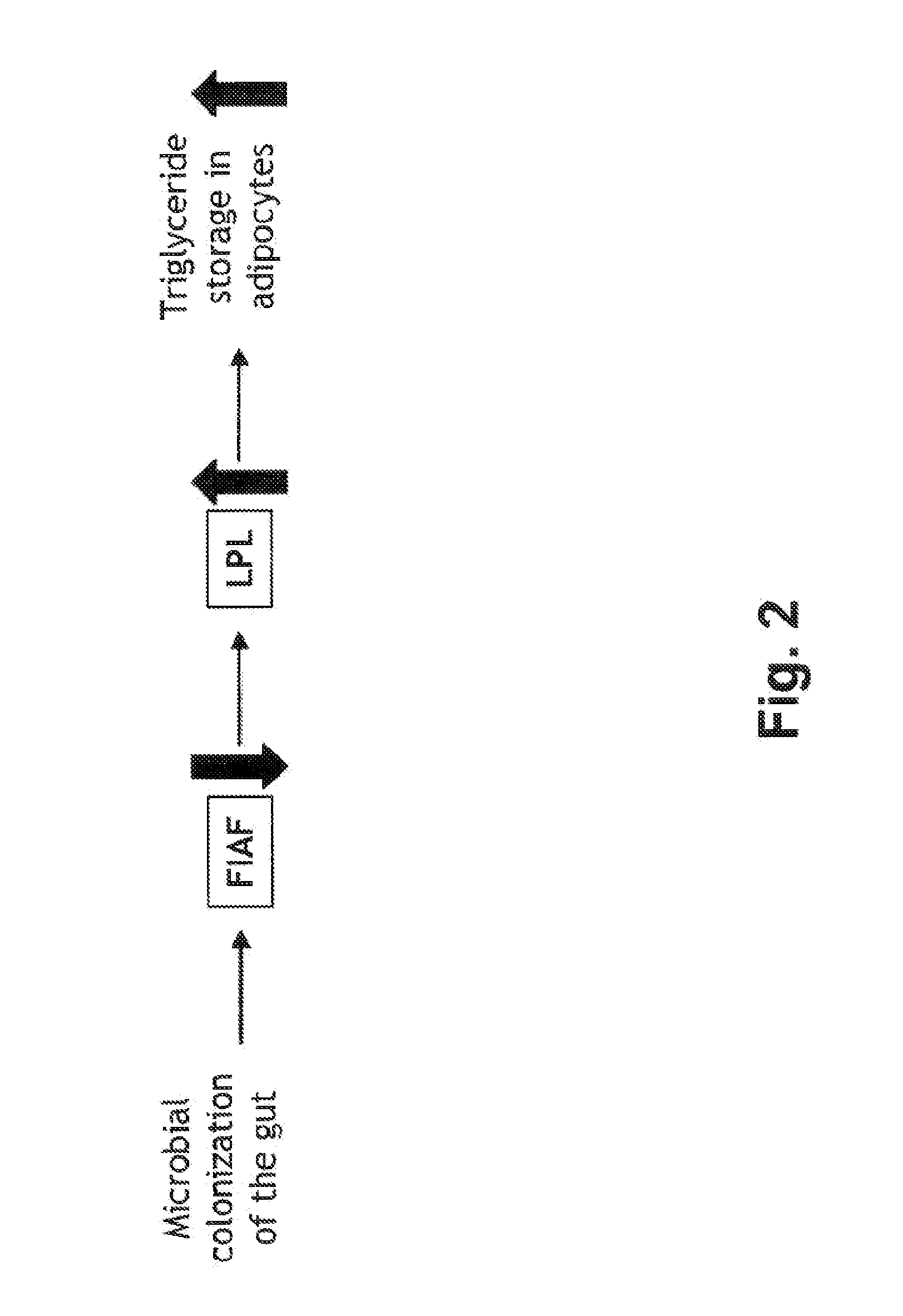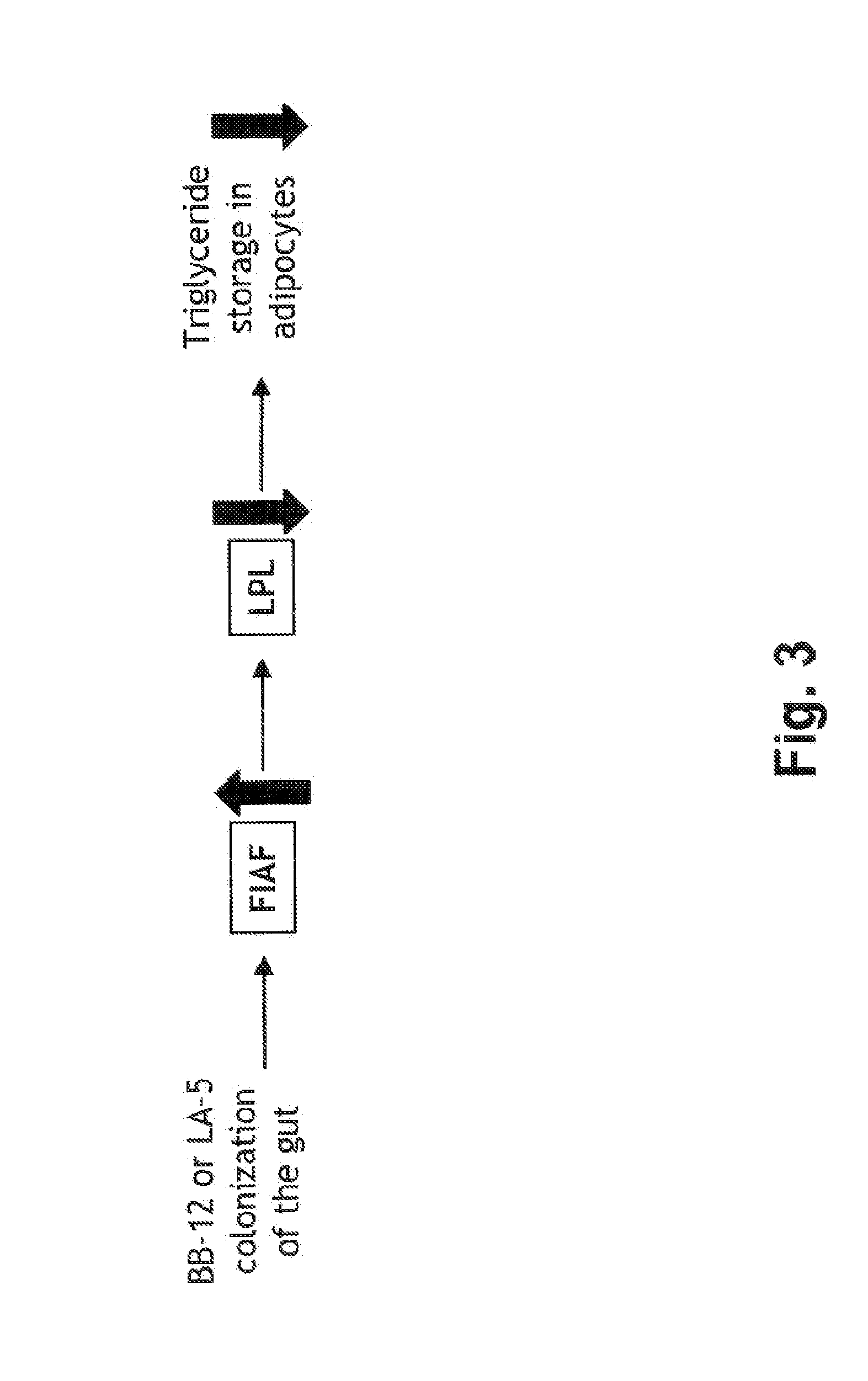Use of probiotics to ameliorate diet-induced insulin resistance
- Summary
- Abstract
- Description
- Claims
- Application Information
AI Technical Summary
Benefits of technology
Problems solved by technology
Method used
Image
Examples
example 1
Probiotic Strain Down-Regulate ELOVL6 Expression in the Ileum of Pigs
[0073]To investigate whether or not selected probiotic strains regulate ileal ELOVL6 expression in animals, young pigs were fed a standard diet including probiotic bacteria (i.e. Bifidobacterium animalis subsp. lactis strain BB-12® (DSM15954), Lactobacillus acidophilus strain LA-5 (DSM13241), and Lactobacillus paracasei subsp. paracasei strain CRL431, (ATCC 55544). Pigs fed with the same standard diet but not supplemented with probiotic bacteria served as control. Each group consisted of 8 piglets. At weaning at 4 weeks the animals were moved to pens where they were housed individually and assigned to the corresponding treatments for 14 days. Littermates were assigned to each of the treatments. The number of barrows and gilts in each treatment was the same. The pigs were fed twice daily, receiving an amount of feed corresponding to 4% of their body weight. The probiotics were given on top of the diet every morning....
example 2
Probiotic Strain Down-Regulate SCD-1 Expression in the Skeletal Muscle of Pigs
[0078]To investigate whether or not selected probiotic strains regulate skeletal muscle SCD-1 expression in animals, young pigs were fed a standard diet including probiotic bacteria (i.e. Bifidobacterium animalis subsp. lactis strain BB-12® (DSM15954), Lactobacillus acidophilus strain LA-5 (DSM13241), and Lactobacillus paracasei subsp. paracasei strain CRL431, (ATCC 55544)) and otherwise treated as in example 1.
[0079]After 14 days of treatment, the pigs were killed and tissues comprising skeletal muscle were sampled and snap-frozen in liquid nitrogen. Gene expression analysis on the distal ileum was performed by quantitative PCR analysis using primers specific for SCD-1. The quantitative PCR analysis was performed essentially as described by Kubista et al.22.
[0080]Primer sequences were,
SCD1-F: 5′-GGG ATA CAG CTC CCC TCA TAG-3′SCD1-R: 5′-AGT TCC GAT GTC TCA AAA TGC-3′
[0081]As indicated in FIG. 5, LA-5 down-...
example 3
Probiotic Strains Up-Regulate ANGPTL4 Expression in the Jejunum, Ileum, and Colon of Pigs
[0082]To investigate whether or not selected probiotic strains regulate intestinal ANGPTL4 expression in animals, young pigs were fed a standard diet including probiotic bacteria, i.e. Bifidobacterium animalis subsp. lactis strain BB-12® (DSM15954) or Lactobacillus acidophilus strain LA-5 (DSM13241) and otherwise treated as in example 1.
[0083]After 14 days of treatment, the pigs were killed and tissues comprising 25% and 75% of the full length of the small intestine (i.e. the proximal and distal part of the small intestine) as well as the colon were sampled and snap-frozen in liquid nitrogen. Gene expression analysis on the intestinal samples was performed by quantitative PCR analysis using primers specific for GCG. The quantitative PCR analysis was performed essentially as described by Kubista et al.22.
[0084]Primer sequences were,
ANGPTL4-F: 5′-TCG ATG GCA GAT TCA GTC AC-3′ANGPTL4-R: 5′-CCT GGG ...
PUM
 Login to View More
Login to View More Abstract
Description
Claims
Application Information
 Login to View More
Login to View More - R&D
- Intellectual Property
- Life Sciences
- Materials
- Tech Scout
- Unparalleled Data Quality
- Higher Quality Content
- 60% Fewer Hallucinations
Browse by: Latest US Patents, China's latest patents, Technical Efficacy Thesaurus, Application Domain, Technology Topic, Popular Technical Reports.
© 2025 PatSnap. All rights reserved.Legal|Privacy policy|Modern Slavery Act Transparency Statement|Sitemap|About US| Contact US: help@patsnap.com



